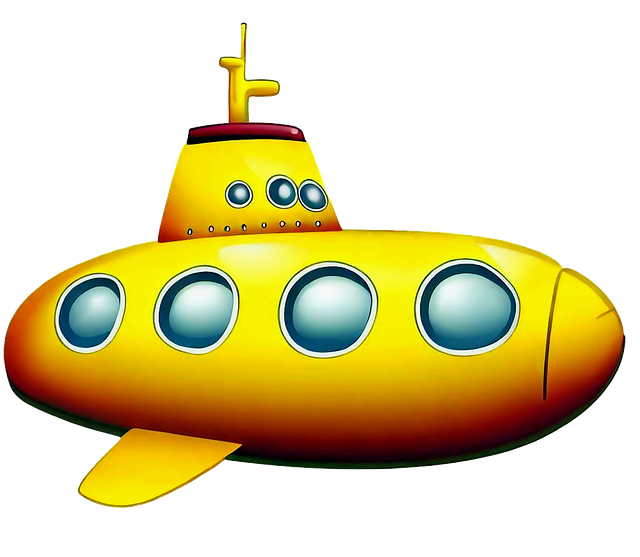Submarines have evolved from basic designs to highly advanced warships with stealth capabilities, sophisticated sensor suites, and powerful propulsion systems. They excel at covert operations, intelligence gathering, and anti-submarine warfare due to their hydrodynamic shapes, specialized materials, and advanced technologies that minimize detectability. Armed with torpedoes, missiles, and cannons, submarines offer strategic advantages in naval warfare, including undetected approaches, precise strikes, and rapid withdrawal. Future submarine technology focuses on integrating AI for enhanced data analysis and stealth advancements to reduce acoustic and electromagnetic signatures, ensuring their crucial role in modern naval operations.
Submarines have evolved from historical roots to become indispensable assets in modern naval warfare. These versatile vessels play a crucial role in protecting global interests, conducting surveillance, and engaging in combat. The article delves into the evolution of submarines, their advanced stealth and camouflage techniques, the formidable armament and warfare tactics they employ, and their strategic significance in various naval operations. Additionally, it explores future prospects shaped by advanced technologies, underscoring why submarines remain a game-changer in maritime security.
- The Evolution of Submarines: From Historical Roots to Modern Design
- Stealth and Camouflage: How Submarines Remain Invisible Under Water
- Armament and Warfare Tactics: The Arsenal of a Submarine
- Strategic Role in Naval Operations: Protecting Interests Globally
- Future Prospects: Advanced Technologies Shaping Submarine Warfare
The Evolution of Submarines: From Historical Roots to Modern Design
Submarines have evolved significantly from their historical roots, transitioning from small, hand-powered vessels to advanced, technologically sophisticated warships. Originally designed for exploration and military applications, early submarines were relatively basic in design, often powered by human effort or simple machinery. Over time, with advancements in engineering and the need for more capable naval assets, submarines underwent a remarkable transformation.
Modern submarines are characterized by sleek, hydrodynamic shapes, advanced propulsion systems, and sophisticated sensor suites. They are designed to operate at great depths, remain undetected, and launch precision strikes. These improvements have made submarines crucial elements of modern navies, enabling them to conduct covert operations, monitor enemy activities, and engage in anti-submarine warfare with unprecedented effectiveness.
Stealth and Camouflage: How Submarines Remain Invisible Under Water
Submarines are masters of stealth, utilizing advanced technology to remain hidden beneath the waves. Their design incorporates specialized materials and intricate systems that minimize their signature, making them nearly invisible to both human observers and modern detection equipment. One key aspect is their shape—streamlined and hydrodynamic, allowing for quiet propulsion and reduced turbulence, which in turn makes it harder for enemies to detect their presence.
Furthermore, submarines employ advanced camouflage techniques, such as painting with infrared or visible light-reflecting materials that mimic the surrounding ocean environment. They can also alter their depth and speed to blend in with underwater currents and light conditions, further enhancing their stealth capabilities. This combination of physical design and tactical maneuvering makes submarines highly effective in modern naval warfare, where covert operations and surprise attacks are often crucial.
Armament and Warfare Tactics: The Arsenal of a Submarine
Submarines, often referred to as the “silent service,” play a pivotal role in modern naval warfare, offering a unique blend of stealth and formidable firepower. Armament and warfare tactics aboard these underwater vessels are designed to strike fear into enemy hearts. Equipped with a diverse array of weapons, including torpedoes, missiles, and cannons, submarines can engage targets both on the surface and beneath the waves.
Their tactical advantages lie in their ability to approach enemies undetected, launch precise strikes, and then disappear back into the depths. This stealth provides a strategic edge, allowing submarines to gather intelligence, patrol sensitive areas, and conduct special operations with minimal risk of detection. With advanced sonar systems and targeted propulsion technologies, these underwater warriors can navigate complex underwater landscapes, making them versatile assets in modern naval fleets.
Strategic Role in Naval Operations: Protecting Interests Globally
Submarines play a strategic role in modern naval warfare, providing a versatile and discreet platform for protecting global interests. Capable of operating unseen beneath the waves, they offer a significant advantage in intelligence gathering, surveillance, and covert operations. With advanced sensors and weaponry, submarines can monitor maritime activity, intercept communications, and respond to threats undetected by surface vessels. This stealth capability is particularly valuable in high-tension regions, where subtlety can prevent escalation and promote de-escalation of conflicts.
Moreover, the strategic reach of submarines extends beyond regional waters. They serve as a deterrent against aggression by projecting power globally. Deployed in various oceans, these versatile warships can quickly respond to crises, ensuring naval dominance and safeguarding national security interests worldwide. This global presence is a key asset in maintaining stability and protecting maritime trade routes, vital for the economy and security of many nations.
Future Prospects: Advanced Technologies Shaping Submarine Warfare
The future of submarine warfare is being shaped by rapid advancements in technology, promising to revolutionize underwater operations. One prominent trend is the integration of advanced sensors and artificial intelligence (AI) systems. These technologies enable submarines to gather and analyze data more efficiently, enhancing their situational awareness and targeting capabilities. For instance, AI-powered sonar systems can detect and track multiple targets simultaneously, improving a submarine’s ability to engage in anti-submarine warfare.
Additionally, the development of stealth technology is set to play a pivotal role. Advanced materials and design concepts are being explored to reduce a submarine’s acoustic and electromagnetic signatures, making them harder to detect. This, coupled with improved propulsion systems, will enable submarines to operate more discreetly and effectively, especially in modern naval missions requiring quiet and precise maneuvers.
Submarines have evolved from historical vessels to modern, advanced weapons systems that play a crucial role in naval warfare. Their unique capabilities in stealth, camouflage, and powerful armament make them indispensable tools for protecting global interests. As technology continues to advance, future prospects for submarine warfare promise even greater capabilities, ensuring their central place in the strategic landscape of modern navies.
